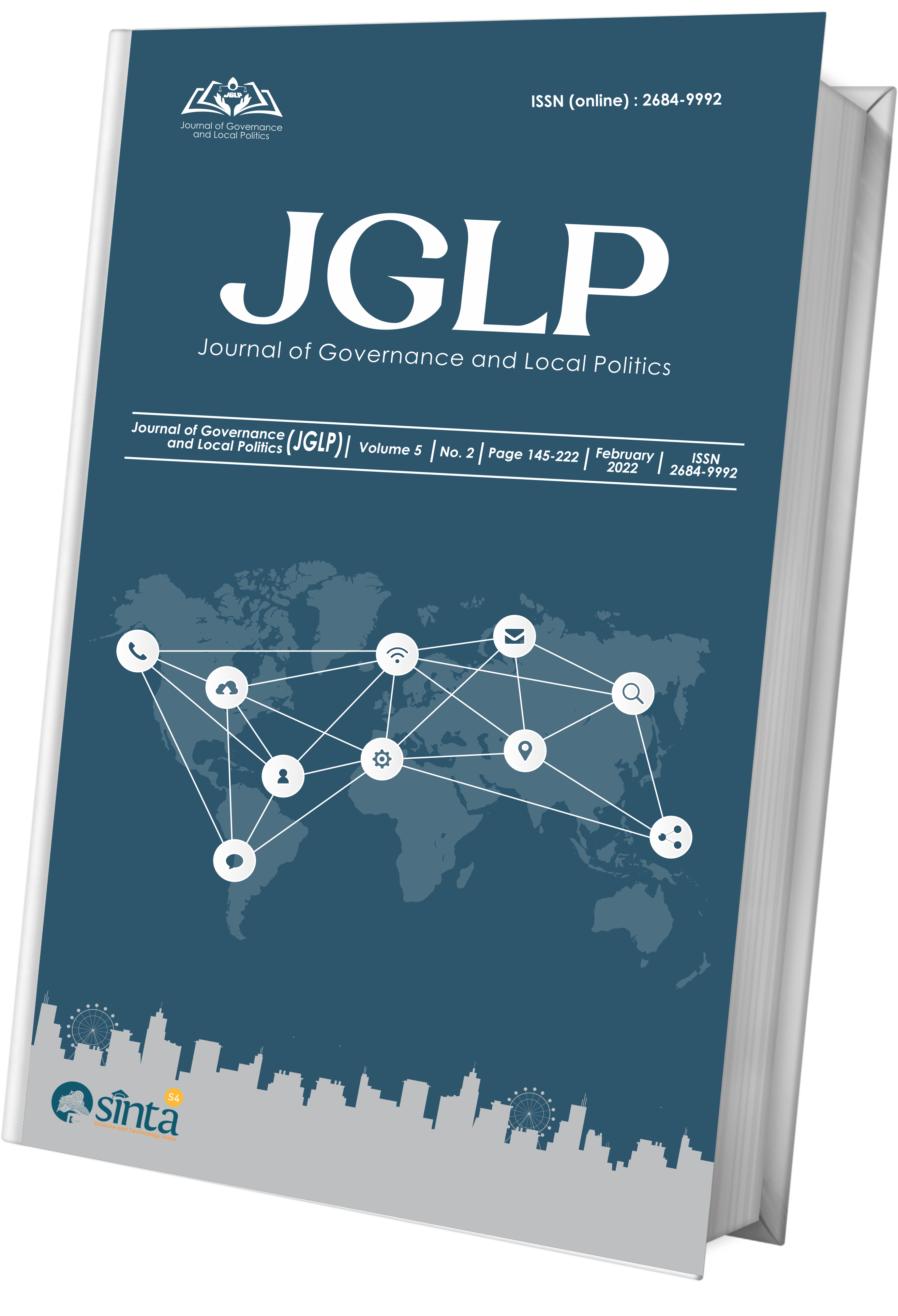“Engines” of Growth, “Sponges” of Labor: A Study on Economic Transformation and the Kuznets Paradox in Kepulauan Riau
Abstract
This study investigates the relationship between structural transformation and regional inequality in Kepulauan Riau (Kepri), Indonesia, a province strategically located as an industrial and service hub yet marked by persistent disparities. While the Kuznets hypothesis suggests an inverted-U link between growth and inequality, evidence from archipelagic economies remains limited. The main purpose of this research is to assess whether Kepri follows or diverges from the Kuznets trajectory by analyzing sectoral shifts and their implications for inequality dynamics. Using provincial macro and microeconomic data, this study applies panel data econometrics and productivity decomposition techniques to evaluate both within-sector growth and labor reallocation effects. The results reveal that industrial expansion generates high productivity but limited employment opportunities, while services act as a labor sponge with weak welfare contributions. This dualistic pattern, termed the “structural change penalty,” has amplified inequality across sectors and regions rather than reducing it. The findings underscore the need for stronger industrial linkages, service sector upgrading, and inclusive regional policies to ensure that structural transformation fosters broad-based and equitable development. By shifting the analytical focus from the national to the sub-national level, this study contributes new insights into the role of local governance, spatial politics, and policy choices in shaping divergent development paths in Indonesia.
References
Abdullah, A. J., Doucouliagos, H., & Manning, E. (2015). Are Regional Incomes in Malaysia Converging? Papers of the Regional Science Association, 94, S69–S95. https://doi.org/10.1111/pirs.12105
Acemoğlu, D., & Robinson, J. A. (2000). Why Did the West Extend the Franchise? Democracy, Inequality, and Growth in Historical Perspective. The Quarterly Journal of Economics, 115(4), 1167–1199. https://doi.org/10.1162/003355300555042
Alisjahbana, A. S., Kim, K., Sen, K., Sumner, A., & Yusuf, A. A. (2020). The developer’s dilemma: A survey of structural transformation and inequality dynamics. WIDER Working Paper.
de Vries, G., Arfelt, L., Drees, D., Godemann, M., Hamilton, C., Jessen-Thiesen, B., … Woltjer, P. (2021). The Economic Transformation Database (ETD): content, sources, and methods. https://doi.org/10.35188/UNU-WIDER/WTN/2021-2
Halim, A. A. Y. and P. R. (2021). Inequality and Structural Transformation in Indonesia’s Labor Market (2001-2015). Finland: World Institute for Development Economics Research PP - Finland.
Kim, K., Mungsunti, A., Sumner, A., & Yusuf, A. A. (2020). Structural transformation and inclusive growth: Kuznets’’developer’s dilemma’in Indonesia. World Institute for Development Economic Research (UNU-WIDER).
Kruse, H., Mensah, E., Sen, K., & de Vries, G. (2023). A Manufacturing (Re)Naissance? Industrialization in the Developing World. IMF Economic Review, 71(2), 439–473. https://doi.org/10.1057/s41308-022-00183-7
Kuznets, S. (1955). Economic Growth and Income Inequality. The American Economic Review, 45(1), 1–28.
Li, H., Squire, L., & Zou, H. (1998). Explaining International and Intertemporal Variations in Income Inequality. The Economic Journal, 108(446), 26–43. https://doi.org/10.1111/1468-0297.00271
Maika, A., Mittinty, M., Brinkman, S., Harper, S., Satriawan, E., & Lynch, J. (2013). Changes in Socioeconomic Inequality in Indonesian Children’s Cognitive Function From 2000 to 2007: A Decomposition Analysis. Plos One, 8(10), e78809. https://doi.org/10.1371/journal.pone.0078809
McMillan, M., Rodrik, D., & Verduzco-Gallo, Í. (2014). Globalization, Structural Change, and Productivity Growth, with an Update on Africa. World Development, 63, 11–32. https://doi.org/10.1016/j.worlddev.2013.10.012
Media Center Pemko Batam. (2021, Desember). Hadapi Tantangan Ekonomi, Rudi Paparkan Strategi dan Program Unggulan. Dinas Komunikasi dan Informatika Kota Batam.
Panjawa, J. L., Guritno, D. C., Sugiharti, R. R., Kurniawan, M. L. A., & Damayanti, S. A. (2023). Measuring Inequality Using J-Bonet Index: What Can We Learn From Regional Data? Jejak, 16(1). https://doi.org/10.15294/jejak.v16i1.38850
Riggs, J. E., Hobbs, J., Hobbs, G. R., & Riggs, T. H. (2012). Kuznets Curves Stratified by Mean Per Capita Income, 1969-2007: Implications Regarding Global Economic Development and Income Inequality*. Modern Economy, 03(05), 617–625. https://doi.org/10.4236/me.2012.35081
S., A., & P., N. (2016). Market Access and Structural Transformation: Evidence from Rural Roads in India∗.
Sen, K., Andy, S., & and Yusuf, A. (2020). Double Dividends and Mixed Blessings: Structural Transformation, Income Inequality and Employment Dynamics. The Journal of Development Studies, 56(9), 1638–1642. https://doi.org/10.1080/00220388.2019.1702162
Sen, K., & Baymul, Ç. (2019). Was Kuznets Right?: New Evidence on the Relationship Between Structural Transformation and Inequality. https://doi.org/10.35188/unu-wider/2019/735-4
Setyadharma, A., Oktavilia, S., Utami, S., & Noormalitasari, A. R. (2021). Impacts of Education and Environmental Sustainability on Rural Income Inequality in Indonesia. E3s Web of Conferences, 232, 4003. https://doi.org/10.1051/e3sconf/202123204003
Sutomo, D. A. (2022). Analysis of Factors Affecting Income Inequality in Indonesia From 2016 - 2021. Journal of International Conference Proceedings, 5(2), 22–37. https://doi.org/10.32535/jicp.v5i2.1666
Yusuf, Arief A, Anglingkusumo, R., & Sumner, A. (2021). A Direct Test of Kuznets in a Developing Economy: A Cross-District Analysis of Structural Transformation and Inequality in Indonesia. Regional Studies Regional Science, 8(1), 184–206. https://doi.org/10.1080/21681376.2021.1924850
Yusuf, Arief Anshory, & Halim, P. R. (2021). Inequality and structural transformation in the changing nature of work: The case of Indonesia. WIDER Working Paper.
Copyright (c) 2025 Journal of Governance and Local Politics (JGLP)

This work is licensed under a Creative Commons Attribution-NonCommercial-NoDerivatives 4.0 International License.










